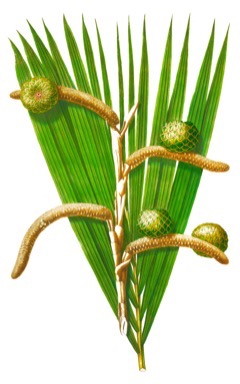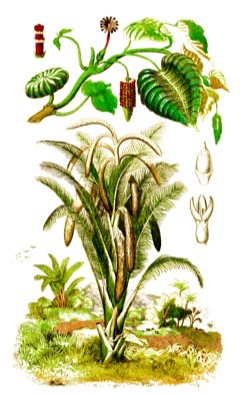 |
|
http://www.edibleplants.org |
 |
| http://www.edibleplants.org |
Translate this page:
Summary
A native to tropical Southeastern Asia, Metroxylon sagu or commonly known as Sago Palm is a multiple-stemmed palm growing about 25 m in height. It has an upright terminal inflorescence and pinnate leaves. The fruit is drupe-like and covered in scales. The trunk is the main source of a starch known as sago which is used in cooking and as food thickener. The apical bud is cooked or consumed raw. The leaves are used as thatching material, or weaved into baskets and mats. The bark can be used as fuel or as flooring material.
Physical Characteristics

 Metroxylon sagu is an evergreen Tree growing to 25 m (82ft) by 10 m (32ft) at a medium rate.
Metroxylon sagu is an evergreen Tree growing to 25 m (82ft) by 10 m (32ft) at a medium rate.
See above for USDA hardiness. It is hardy to UK zone 10. The plant is not self-fertile.
Suitable for: light (sandy), medium (loamy) and heavy (clay) soils and can grow in heavy clay soil. Suitable pH: mildly acid, neutral and basic (mildly alkaline) soils and can grow in very acid and saline soils.
It cannot grow in the shade. It prefers moist or wet soil. The plant can tolerate maritime exposure.
UK Hardiness Map
US Hardiness Map
Synonyms
Metroxylon rumphii (Willd.) Mart. Metroxylon hermaphroditum Hassk. Metroxylon inerme (Roxb.) Mart. M
Plant Habitats
Edible Uses
Edible Parts: Apical bud Fruit Stem
Edible Uses:
The pith of the stem is rich in starch. This has been widely used to make sago[297 ]. The stem is cut down shortly before the tree flowers, since the carbohydrate content is then at its highest[314 ]. It is chopped into sections and the fibrous inside is washed to extract the starch[200 , 297 ]. Hot water is poured over the slightly sour wet starch and stirred. The resulting glue-like mass is eaten with fish and vegetable dishes[303 ]. Usually, the wet starch extracted from the stems is boiled, fried or roasted, alone or mixed with other foodstuffs[418 ]. It is also used industrially in the manufacture of cakes, noodles, kerupuk and custard powders[418 ]. The fully ripe fruit is astringent, but is eaten as a delicacy by local people[301 ]. Apical bud - raw or cooked[418 ]. It is commonly steamed and eaten as a side dish with rice or added to stews[301 ]. Harvesting this bud effectively eventually kills the individual trunk because it is unable to make side branches[301 ].
References More on Edible Uses
Medicinal Uses
Plants For A Future can not take any responsibility for any adverse effects from the use of plants. Always seek advice from a professional before using a plant medicinally.
None known
References More on Medicinal Uses
The Bookshop: Edible Plant Books
Our Latest books on Perennial Plants For Food Forests and Permaculture Gardens in paperback or digital formats.

Edible Tropical Plants
Food Forest Plants for Hotter Conditions: 250+ Plants For Tropical Food Forests & Permaculture Gardens.
More

Edible Temperate Plants
Plants for Your Food Forest: 500 Plants for Temperate Food Forests & Permaculture Gardens.
More

More Books
PFAF have eight books available in paperback and digital formats. Browse the shop for more information.
Shop Now
Other Uses
Alcohol Fencing Fertilizer Fibre Fodder Fuel Nails Paper Shelterbelt Soil stabilization Thatching Weaving Wood
Agroforestry Uses: Sago palm has been planted in buffer zones as a method of rehabilitating degraded lands, for instance the coastal plains of Indonesia where thousands of hectares of land had been abandoned[303 ]. Especially when in wetter soils, the roots help to stabilize the soil by trapping silt[312 ]. Young palms, with their numerous spines, act as effective barriers for livestock and potential trespassers. As the palms mature and develop above-ground stems, new palms may be planted adjacent to the juveniles to maintain the spininess of the fence[312 ]. Other Uses The leaves, and the fibres obtained from them, are commonly used for thatching, weaving mats etc[297 , 303 ]. It is said that thatch made from this plant will last for at least 5 years[314 ]. Processing of the pith to yield starch produces a fibre[303 ]. The waste from pith processing is used as a fertilizer[303 ]. Dextrose sugar extract from sago palm starch can be processed to yield alcohol for use as a biofuel[303 , 418 ]. The starch obtained from the stems is also used for various other products including to make a sizing paste for paper and textiles[418 ]. The cortex of the trunk is also used for firing in paper mills[303 ]. The bark may be used as a domestic fuel after drying[303 ]. The frond rachis is often used for fastening between horizontal posts in walls[303 ]. The bark may be used as a flooring material[303 ]. The hard outside of the trunk is used for building purposes[297 ].
Special Uses
Carbon Farming Food Forest
References More on Other Uses
Cultivation details
Agroforestry Services: Windbreak Fodder: Insect Industrial Crop: Fiber Management: Managed Multistem Regional Crop Staple Crop: Basic Starch
Sago palm succeeds in wet, lowland tropical climates where it is found at elevations from sea level to 700 metres[297 , 303 ]. It grows best in areas where annual daytime temperatures are within the range 25 - 36°c, but can tolerate 18 - 40°c[418 ]. When dormant, the plant can survive temperatures down to about 10°c[418 ]. It prefers a mean annual rainfall in the range 3,000 - 4,500mm, but tolerates 2,100 - 5,800mm[418 ]. Plants grow well in full sun, even when small[297 ]. They grow best in clay soils with a high organic-matter content[303 ]. In the wild, the plant grows on mineral rich soils with a pH of 4.5 or more[303 ]. Prefers a pH in the range 5.5 - 6.5, tolerating 4.5 - 8.5[418 ]. Plants can be grown in soils with very high water tables, succeeding even in swamps. They can even tolerate occasional flooding with saline water[418 ]. Sago palm is hapaxanthic[303 ]. Each trunk lives for a number of years without flowering but, once it has flowered and fruited, the leaves senesce and the trunk dies completely. However, one or more suckers develop from the base and take over[303 ]. The vegetative growth phase lasts for at least 8 years before the tree flowers[303 ]. A single palm may yield about 180 - 350 kilos of sago[418 ]. It has been calculated that the labour requirement for each kilo of starch obtained from this plant is far less than for any other starch producing plant[297 ]. There are hermaphroditic and male flowers[303 ]. The palm can be classified as a nearly complete obligatory cross-breeder, with easy vegetative multiplication[303 ]. Spacing: 15-20 ft. (4.7-6 m) 20-30 ft. (6-9 m) 30-40 ft. (9-12 m).
Carbon Farming
-
Agroforestry Services: Windbreak
Linear plantings of trees and shrubs designed to enhance crop production, protect people and livestock and benefit soil and water conservation.
-
Fodder: Insect
Plants grown for useful fodder insects.
-
Industrial Crop: Fiber
Clothing, rugs, sheets, blankets etc. Currently, almost none of our fiber are produced from perennial crops but could be!
-
Management: Managed Multistem
Regularly removing some multiple stems. A non-A non-destructive management systems maintaining the soil organic carbon.
-
Regional Crop
These crops have been domesticated and cultivated regionally but have not been adopted elsewhere and are typically not traded globally, Examples in this broad category include perennial cottons and many nuts and staple fruits.
-
Staple Crop: Basic Starch
The Carbon Farming Solution. Eric Toensmeier.
References Carbon Farming Information and Carbon Sequestration Information
Temperature Converter
Type a value in the Celsius field to convert the value to Fahrenheit:
Fahrenheit:
The PFAF Bookshop
Plants For A Future have a number of books available in paperback and digital form. Book titles include Edible Plants, Edible Perennials, Edible Trees,Edible Shrubs, Woodland Gardening, and Temperate Food Forest Plants. Our new book is Food Forest Plants For Hotter Conditions (Tropical and Sub-Tropical).
Shop Now
Plant Propagation
Seed - pre-soak for 24 hours in warm water and sow in containers[297 ]. Germination usually takes several months. The seed germinates only under wet conditions[303 ]. A rosette grows from the seed, out of which a new bole and new suckers may be formed[303 ]. Division of suckers[297 ]. The suckers have the advantage of being readily available and of producing homogeneous offspring, which allows selection of superior forms[303 ].
Other Names
If available other names are mentioned here
Sago Palm, Ambasao, Ambulung, Ambusao, Balau, Bulu, Bulung, Chr ae saku, Kersula, Kirai, Kresula, Lumbia, Palma de sago, Pohon rumbia, Pohon sagu, Rajang bunkoan, Rambia, Rembi, Rembia, Rembulung, Resula, Rontan, Rumbia, Sa khu, Sago yashi, Sagopalme, Sagoutier, Sagu, Saksak, Tembulu, Tha-gu-bin, Xi mi zong,
Native Range
TROPICAL ASIA: Papua New Guinea, Thailand, Indonesia, Malaysia, Philippines, PACIFIC: Fiji
Weed Potential
Right plant wrong place. We are currently updating this section.
Please note that a plant may be invasive in one area but may not in your area so it's worth checking.
Conservation Status
IUCN Red List of Threatened Plants Status : This taxon has not yet been assessed

Growth: S = slow M = medium F = fast. Soil: L = light (sandy) M = medium H = heavy (clay). pH: A = acid N = neutral B = basic (alkaline). Shade: F = full shade S = semi-shade N = no shade. Moisture: D = dry M = Moist We = wet Wa = water.
Now available:
Food Forest Plants for Mediterranean Conditions
350+ Perennial Plants For Mediterranean and Drier Food Forests and Permaculture Gardens.
[Paperback and eBook]
This is the third in Plants For A Future's series of plant guides for food forests tailored to
specific climate zones. Following volumes on temperate and tropical ecosystems, this book focuses
on species suited to Mediterranean conditions—regions with hot, dry summers and cool, wet winters,
often facing the added challenge of climate change.
Read More
Expert comment
Author
Rottb.
Botanical References
Links / References
For a list of references used on this page please go here
A special thanks to Ken Fern for some of the information used on this page.
Readers comment
| Add a comment |
|
If you have important information about this plant that may help other users please add a comment or link below. Only comments or links that are felt to be directly relevant to a plant will be included. If you think a comment/link or information contained on this page is inaccurate or misleading we would welcome your feedback at [email protected]. If you have questions about a plant please use the Forum on this website as we do not have the resources to answer questions ourselves.
* Please note: the comments by website users are not necessarily those held by PFAF and may give misleading or inaccurate information.
To leave a comment please Register or login here All comments need to be approved so will not appear immediately.
|
Subject : Metroxylon sagu
|
|
|
|